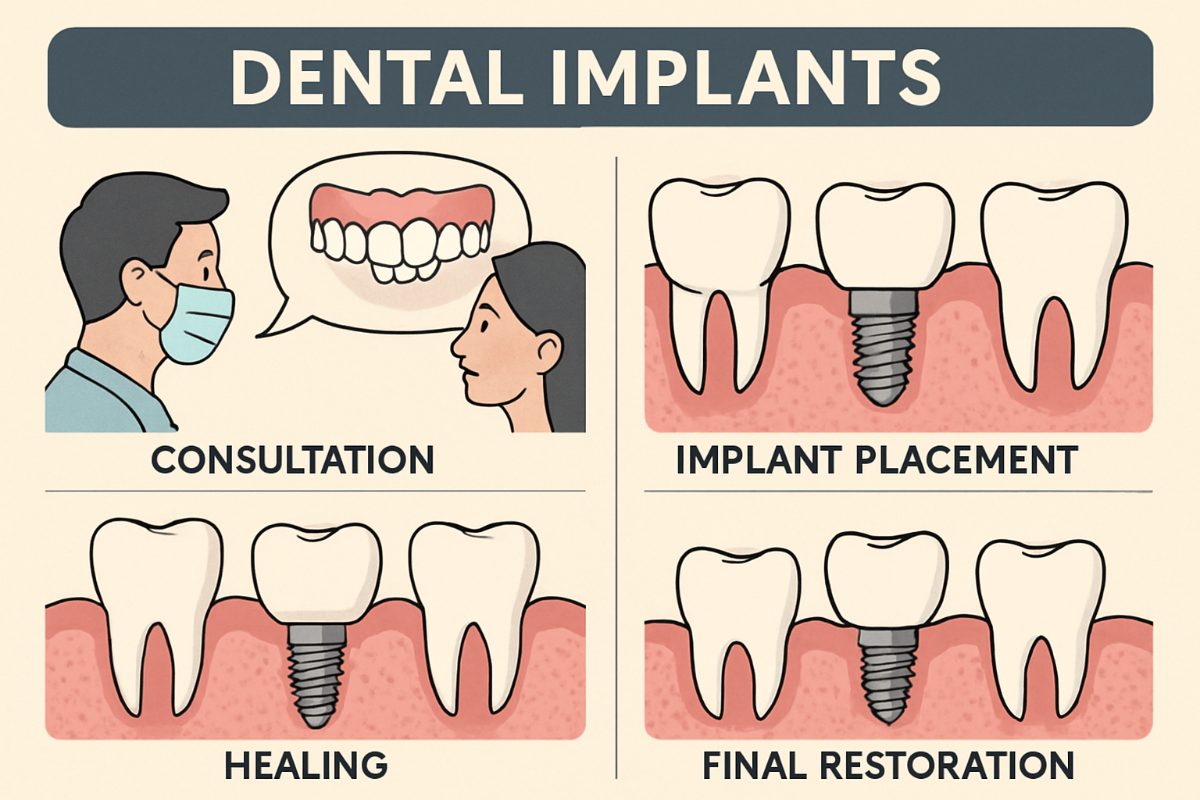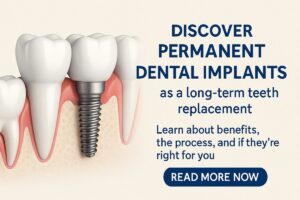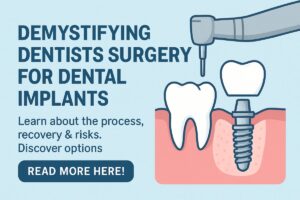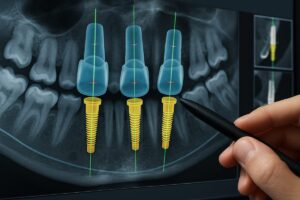The process of dental implants replaces missing teeth with strong, long-lasting solutions that look and work like real teeth. This post breaks the process of dental implants into simple stages so you know what to expect, why each step matters, and the practical next steps you can take.
Read on if you are thinking about implants, were told you’re not a candidate before, or want a straightforward view of the timeline and choices involved.
What Are Dental Implants?
Dental implants are titanium posts placed into the jaw that act like tooth roots. Each implant usually has three parts: the implant (the post), the abutment (the connector), and the crown (the visible tooth). Together they restore chewing, speech, and appearance more naturally than dentures or bridges.
People choose implants for single missing teeth, multiple missing teeth, or full-arch replacements. Implants preserve bone, feel stable, and can last many years with proper care.
Step-by-Step Look At The Process Of Dental Implants
This section walks through the typical process of dental implants so you can plan time, travel, and costs.
Initial consult and imaging
The first visit includes a dental exam, review of your medical and dental history, and detailed imaging. We use CT scans to map your jaw and nerves — CT scans are offered free with our consultation. Digital photos and digital impressions help document your bite and plan the prosthetic.
Digital planning and smile design
We create a precise digital plan using facial scanners, intraoral scanners, and photogrammetry. These tools let us design the ideal implant positions and the look of your final teeth. Digital planning reduces surprises and speeds the process of making your restorations.
Surgical placement
On surgery day, implants are placed under local anesthesia, IV sedation, or general anesthesia depending on your needs. There are many implant types; some patients get immediate placement and temporary teeth the same day, while others have staged placement to allow healing first. Your surgeon will explain which approach fits your case.
Special techniques for low bone cases
If you’ve been told you have “no bone,” there are advanced options. Zygomatic and pterygoid implants anchor into cheek or back jaw bones. Transsinus and subperiosteal implants sit differently to avoid needing large grafts. These techniques let many patients receive implants who were previously told they couldn’t.
Temporary teeth and healing (osseointegration)
After surgery you may wear a temporary prosthesis. Implants need time to fuse to bone — a process called osseointegration — which usually takes a few months. During healing, follow dietary limits and oral care instructions to protect the implants and soft tissue.
Final restoration and follow-up
Once healed, the final crowns, bridges, or All‑on‑X prosthesis are attached. We check fit, bite, and comfort, and schedule follow-up visits to monitor healing. Long-term maintenance includes regular cleanings and home care to keep implants healthy.
Who Is A Good Candidate For Implants?
Good candidates are in generally stable health, have healthy gums, and enough bone for implant support. Smoking, uncontrolled diabetes, and certain medical conditions increase risk and may need management before surgery. Advanced implant techniques can help many people who were once told they were not candidates.
Risks, Recovery, And What To Expect
Short-term side effects include swelling, bruising, and temporary discomfort. There is a small risk of infection or nerve irritation. Contact your surgeon if you have high fever, increasing pain, uncontrolled bleeding, or numbness that worsens. Most patients return to normal activity in a few days to a couple of weeks, with full restoration completed over months.
Travel, Scheduling, And Care With Out‑of‑State Patients
Many patients travel for care. You can meet the surgeon the day before surgery and return home the day after the procedure. Postoperative checks are coordinated with your referring dentist, and you return for the final prosthetic check months later. We provide clear instructions and coordinate care to make travel simple and safe.
Why Choose A Board‑Certified Implant Specialist
Board certification means advanced training, experience, and a commitment to high standards. Dr. Michael Fioritto is one of about nine board‑certified implant specialists in Ohio. He has taught local dentists and labs the digital All‑on‑X workflow and uses facial scanners, intraoral scanners, and photogrammetry to plan and place implants precisely.
Free Consultation And Next Steps
We offer free consultations and free CT scans to review your case and explain the process of dental implants for your smile. To schedule, call our office or request an appointment online. Bring a list of medications, any recent dental records or x-rays, and your questions so we can make a clear plan together.






